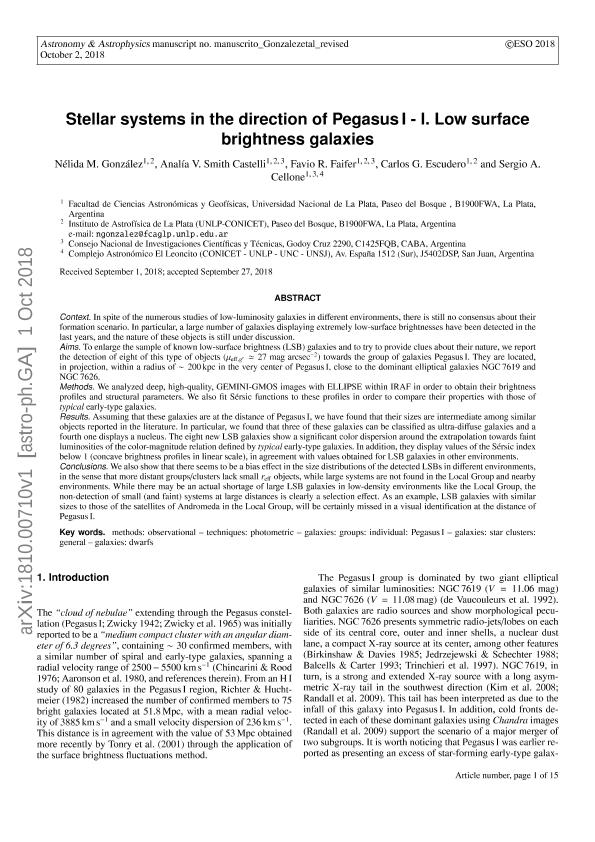Mostrar el registro sencillo del ítem
dc.contributor.author
Gonzalez, Nelida Mabel

dc.contributor.author
Smith Castelli, Analia Viviana

dc.contributor.author
Faifer, Favio Raúl

dc.contributor.author
Escudero, Carlos Gabriel

dc.contributor.author
Cellone, Sergio Aldo

dc.date.available
2019-10-21T13:51:45Z
dc.date.issued
2018-12-01
dc.identifier.citation
Gonzalez, Nelida Mabel; Smith Castelli, Analia Viviana; Faifer, Favio Raúl; Escudero, Carlos Gabriel; Cellone, Sergio Aldo; Stellar systems in the direction of Pegasus I: I. Low surface brightness galaxies; EDP Sciences; Astronomy and Astrophysics; 620; 1-12-2018; 1-15
dc.identifier.issn
0004-6361
dc.identifier.uri
http://hdl.handle.net/11336/86565
dc.description.abstract
Context. In spite of the numerous studies of low-luminosity galaxies in different environments, there is still no consensus about their formation scenario. In particular, a large number of galaxies displaying extremely low surface brightnesses have been detected in recent years and the nature of these objects is still under discussion. Aims. In order to enlarge the sample of known low-surface-brightness (LSB) galaxies and to try to provide clues about their nature, we report the detection of eight such objects (μ eff,g′ â 27 mag arcsec -2 ) towards the group of galaxies Pegasus I. They are located, in projection, within a radius of ∼200 kpc in the very center of Pegasus I, close to the dominant elliptical galaxies NGC 7619 and NGC 7626. Methods. We analyzed deep, high-quality GEMINI-GMOS images with ELLIPSE within IRAF in order to obtain their brightness profiles and structural parameters. We also fit Sérsic functions to these profiles in order to compare their properties with those of typical early-Type galaxies. Results. Assuming that these galaxies are at the distance of Pegasus I, we have found that their sizes are intermediate among similar objects reported in the literature. In particular, we found that three of these galaxies can be classified as ultra-diffuse galaxies and a fourth one displays a nucleus. The eight new LSB galaxies show significant color dispersion around the extrapolation towards faint luminosities of the color-magnitude relation defined by typical early-Type galaxies. In addition, they display values of the Sérsic index below 1 (concave brightness profiles in linear scale), in agreement with values obtained for LSB galaxies in other environments. Conclusions. We show that there seems to be a bias effect in the size distributions of the detected LSBs in different environments, in the sense that more distant groups/clusters lack small r eff objects, while large systems are not found in the Local Group and nearby environments. While there may be an actual shortage of large LSB galaxies in low-density environments like the Local Group, the non-detection of small (and faint) systems at large distances is clearly a selection effect. As an example, LSB galaxies with similar sizes to those of the satellites of Andromeda in the Local Group will be certainly missed in a visual identification at the distance of Pegasus I.
dc.format
application/pdf
dc.language.iso
eng
dc.publisher
EDP Sciences

dc.rights
info:eu-repo/semantics/openAccess
dc.rights.uri
https://creativecommons.org/licenses/by-nc-sa/2.5/ar/
dc.subject
GALAXIES: DWARF
dc.subject
GALAXIES: GROUPS: INDIVIDUAL: PEGASUS I
dc.subject
GALAXIES: STAR CLUSTERS: GENERAL
dc.subject
METHODS: OBSERVATIONAL
dc.subject
TECHNIQUES: PHOTOMETRIC
dc.subject.classification
Astronomía

dc.subject.classification
Ciencias Físicas

dc.subject.classification
CIENCIAS NATURALES Y EXACTAS

dc.title
Stellar systems in the direction of Pegasus I: I. Low surface brightness galaxies
dc.type
info:eu-repo/semantics/article
dc.type
info:ar-repo/semantics/artículo
dc.type
info:eu-repo/semantics/publishedVersion
dc.date.updated
2019-10-15T14:10:14Z
dc.journal.volume
620
dc.journal.pagination
1-15
dc.journal.pais
Francia

dc.journal.ciudad
Paris
dc.description.fil
Fil: Gonzalez, Nelida Mabel. Consejo Nacional de Investigaciones Científicas y Técnicas. Centro Científico Tecnológico Conicet - La Plata. Instituto de Astrofísica La Plata. Universidad Nacional de La Plata. Facultad de Ciencias Astronómicas y Geofísicas. Instituto de Astrofísica La Plata; Argentina
dc.description.fil
Fil: Smith Castelli, Analia Viviana. Consejo Nacional de Investigaciones Científicas y Técnicas. Centro Científico Tecnológico Conicet - La Plata. Instituto de Astrofísica La Plata. Universidad Nacional de La Plata. Facultad de Ciencias Astronómicas y Geofísicas. Instituto de Astrofísica La Plata; Argentina
dc.description.fil
Fil: Faifer, Favio Raúl. Consejo Nacional de Investigaciones Científicas y Técnicas. Centro Científico Tecnológico Conicet - La Plata. Instituto de Astrofísica La Plata. Universidad Nacional de La Plata. Facultad de Ciencias Astronómicas y Geofísicas. Instituto de Astrofísica La Plata; Argentina
dc.description.fil
Fil: Escudero, Carlos Gabriel. Consejo Nacional de Investigaciones Científicas y Técnicas. Centro Científico Tecnológico Conicet - La Plata. Instituto de Astrofísica La Plata. Universidad Nacional de La Plata. Facultad de Ciencias Astronómicas y Geofísicas. Instituto de Astrofísica La Plata; Argentina
dc.description.fil
Fil: Cellone, Sergio Aldo. Consejo Nacional de Investigaciones Científicas y Técnicas. Centro Científico Tecnológico Conicet - La Plata. Instituto de Astrofísica La Plata. Universidad Nacional de La Plata. Facultad de Ciencias Astronómicas y Geofísicas. Instituto de Astrofísica La Plata; Argentina
dc.journal.title
Astronomy and Astrophysics

dc.relation.alternativeid
info:eu-repo/semantics/altIdentifier/url/https://www.aanda.org/10.1051/0004-6361/201834172
Archivos asociados
